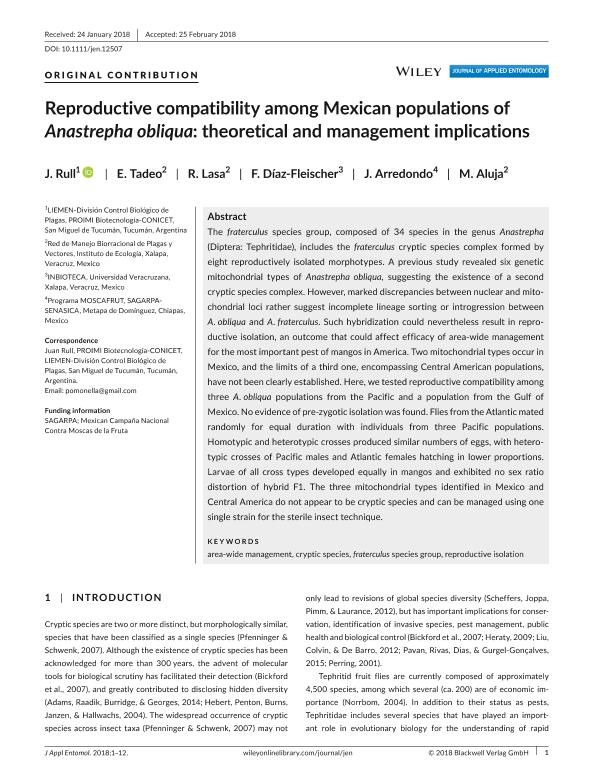Mostrar el registro sencillo del ítem
dc.contributor.author
Rull Gabayet, Juan Antonio

dc.contributor.author
Tadeo, Nidia Silvia Juana

dc.contributor.author
Lasa, R.
dc.contributor.author
Díaz Fleischer, F.
dc.contributor.author
Arredondo, J.
dc.contributor.author
Aluja, M.
dc.date.available
2019-08-28T12:36:26Z
dc.date.issued
2018-03
dc.identifier.citation
Rull Gabayet, Juan Antonio; Tadeo, Nidia Silvia Juana; Lasa, R.; Díaz Fleischer, F.; Arredondo, J.; et al.; Reproductive compatibility among Mexican populations of Anastrepha obliqua : theoretical and management implications; Wiley Blackwell Publishing, Inc; Journal of Applied Entomology; 142; 2; 3-2018; 667-678
dc.identifier.issn
0931-2048
dc.identifier.uri
http://hdl.handle.net/11336/82331
dc.description.abstract
The fraterculus species group, composed of 34 species in the genus Anastrepha(Diptera: Tephritidae), includes the fraterculus cryptic species complex formed by eight reproductively isolated morphotypes. A previous study revealed six genetic mitochondrial types of Anastrepha obliqua, suggesting the existence of a second cryptic species complex. However, marked discrepancies between nuclear and mitochondrial loci rather suggest incomplete lineage sorting or introgression between A. obliqua and A. fraterculus. Such hybridization could nevertheless result in reproductive isolation, an outcome that could affect efficacy of area-wide management for the most important pest of mangos in America. Two mitochondrial types occur in Mexico, and the limits of a third one, encompassing Central American populations, have not been clearly established. Here, we tested reproductive compatibility among three A. obliqua populations from the Pacific and a population from the Gulf of Mexico. No evidence of pre-zygotic isolation was found. Flies from the Atlantic mated randomly for equal duration with individuals from three Pacific populations. Homotypic and heterotypic crosses produced similar numbers of eggs, with heterotypic crosses of Pacific males and Atlantic females hatching in lower proportions. Larvae of all cross types developed equally in mangos and exhibited no sex ratio mdistortion of hybrid F1. The three mitochondrial types identified in Mexico andCentral America do not appear to be cryptic species and can be managed using onesingle strain for the sterile insect technique.
dc.format
application/pdf
dc.language.iso
eng
dc.publisher
Wiley Blackwell Publishing, Inc

dc.rights
info:eu-repo/semantics/openAccess
dc.rights.uri
https://creativecommons.org/licenses/by-nc-sa/2.5/ar/
dc.subject
Area-Wide Management
dc.subject
Cryptic Species
dc.subject
Fraterculus Species Group
dc.subject
Reproductive Isolation
dc.subject.classification
Zoología, Ornitología, Entomología, Etología

dc.subject.classification
Ciencias Biológicas

dc.subject.classification
CIENCIAS NATURALES Y EXACTAS

dc.title
Reproductive compatibility among Mexican populations of Anastrepha obliqua : theoretical and management implications
dc.type
info:eu-repo/semantics/article
dc.type
info:ar-repo/semantics/artículo
dc.type
info:eu-repo/semantics/publishedVersion
dc.date.updated
2019-08-27T13:28:28Z
dc.journal.volume
142
dc.journal.number
2
dc.journal.pagination
667-678
dc.journal.pais
Reino Unido

dc.journal.ciudad
Londres
dc.description.fil
Fil: Rull Gabayet, Juan Antonio. Consejo Nacional de Investigaciones Científicas y Técnicas. Centro Científico Tecnológico Conicet - Tucumán. Planta Piloto de Procesos Industriales Microbiológicos; Argentina
dc.description.fil
Fil: Tadeo, Nidia Silvia Juana. Instituto de Ecología A.c.; México
dc.description.fil
Fil: Lasa, R.. Instituto de Ecología A.c.; México
dc.description.fil
Fil: Díaz Fleischer, F.. Universidad Veracruzana; México
dc.description.fil
Fil: Arredondo, J.. Campaña Nacional Contra Moscas de la Fruta; México
dc.description.fil
Fil: Aluja, M.. Instituto de Ecología A.c.; México
dc.journal.title
Journal of Applied Entomology

dc.relation.alternativeid
info:eu-repo/semantics/altIdentifier/url/https://onlinelibrary.wiley.com/doi/abs/10.1111/jen.12507
dc.relation.alternativeid
info:eu-repo/semantics/altIdentifier/doi/https://dx.doi.org/10.1111/jen.12507
Archivos asociados
